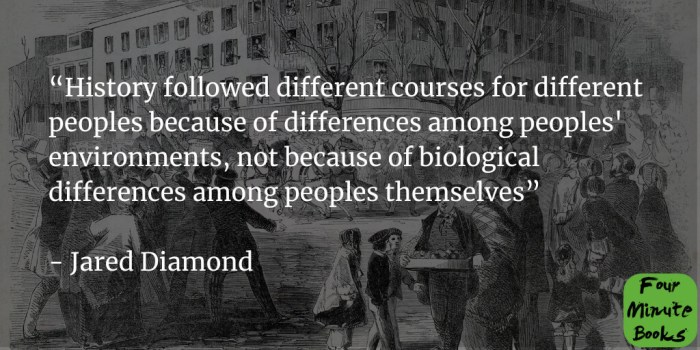Guns germs and steel episode 1 answers – Guns, Germs, and Steel Episode 1 answers the enigmatic question of why some civilizations flourished while others faltered. This thought-provoking episode embarks on a journey through the annals of time, exploring the intricate tapestry of geography, technology, and disease that shaped the destiny of human societies.
From the vast expanse of Eurasia to the isolated shores of the Americas, this episode unveils the profound impact of environmental factors, agricultural advancements, and the spread of ideas and pathogens. Prepare to delve into a captivating narrative that challenges conventional wisdom and sheds light on the complexities of human history.
Introduction to “Guns, Germs, and Steel: Episode 1”: Guns Germs And Steel Episode 1 Answers
Episode 1 of “Guns, Germs, and Steel” introduces the central thesis of the documentary series: that the geographical and environmental factors of a region played a significant role in the development of human civilizations. The episode argues that the Eurasian landmass had a number of advantages over other continents, such as its vast size, diverse climate, and abundance of domesticable plants and animals.
These advantages allowed Eurasian societies to develop agriculture, technology, and political organization more rapidly than societies in other parts of the world.
The Role of Geography
Climate
The climate of a region played a major role in the development of human societies. Warm climates allowed for the cultivation of a wider variety of crops, while cold climates forced people to rely on hunting and gathering. Arid climates made it difficult for people to settle in permanent locations, while humid climates were more conducive to the spread of disease.
Resources, Guns germs and steel episode 1 answers
The availability of resources also had a major impact on the development of human societies. Societies that had access to abundant resources, such as fertile land, water, and minerals, were able to grow and prosper more easily than societies that lacked these resources.
Disease
Disease was a major factor in the development of human history. Diseases such as smallpox, measles, and malaria killed millions of people and had a devastating impact on the development of civilizations.
The Importance of Agriculture

The development of agriculture was one of the most important turning points in human history. Agriculture allowed people to produce their own food, which led to increased population growth and the rise of civilizations. Agriculture also led to the development of new technologies, such as irrigation and crop rotation.
The Spread of Technology and Disease

The spread of technology and disease played a major role in the interactions between different societies. The development of weapons, such as guns and gunpowder, gave Europeans a significant advantage over Native American societies. The spread of disease also had a major impact on the history of the Americas.
Diseases such as smallpox and measles killed millions of Native Americans and made it easier for Europeans to conquer the continent.
The Rise of Complex Societies

The development of complex societies was a gradual process that took place over thousands of years. The first complex societies emerged in Mesopotamia and Egypt around 3500 BC. These societies were characterized by the development of writing, bureaucracy, and social stratification.
The Impact of Guns, Germs, and Steel on the Americas
The arrival of Europeans in the Americas had a devastating impact on the indigenous populations. The Europeans brought with them guns, germs, and steel, which gave them a significant advantage over the Native Americans. The Europeans also used their superior technology to enslave and exploit the Native Americans.
Modern Implications of the Episode
The ideas presented in “Guns, Germs, and Steel” have important implications for our understanding of the modern world. The episode shows that the development of human civilizations was not a random process. Rather, it was shaped by a number of factors, including geography, environment, and technology.
This understanding can help us to avoid the mistakes of the past and build a more just and equitable world.
FAQ Section
What is the main thesis of Guns, Germs, and Steel Episode 1?
The main thesis is that the geographical, technological, and disease-related advantages possessed by Eurasian societies allowed them to dominate and shape the course of human history.
How did geography influence the development of human societies?
Geography played a crucial role by determining access to resources, climate conditions, and the spread of disease, which in turn influenced the growth, stability, and interactions of different societies.
What was the impact of agriculture on human history?
Agriculture led to increased food production, population growth, and the rise of sedentary communities, which paved the way for the development of complex societies and civilizations.
How did the spread of technology and disease shape human interactions?
The spread of technology, such as weapons and transportation, enabled societies to conquer and interact with distant lands. Disease also played a significant role, both as a threat and a catalyst for adaptation and immunity.
What factors contributed to the rise of complex societies?
The rise of complex societies was influenced by factors such as the development of writing, bureaucracy, social stratification, and the emergence of centralized authority.